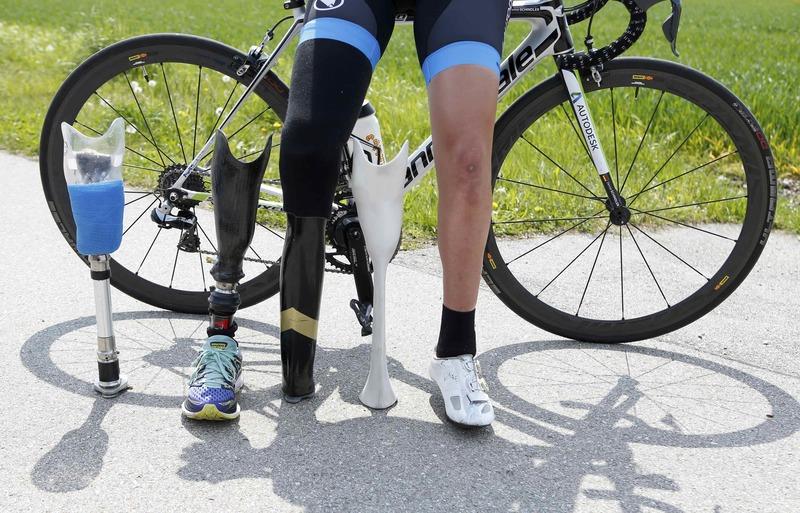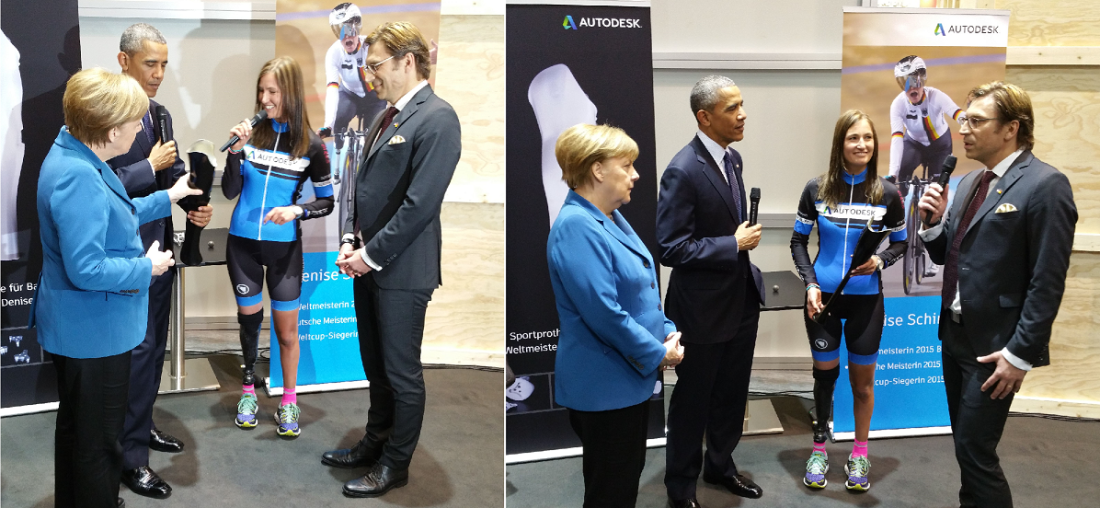 When the Paralympics come to Rio de Janeiro this September, German silver medal winning cyclist Denise Schindler is hoping to be the first to race in the games using a 3D printed prosthetic device. The prosthetic device was designed as a collaboration between Schindler and 3D software developer Autodesk. With a goal of making it easier for disabled athletes to afford specialized athletic prosthesis, the device developed by Autodesk is less expensive, requires less specialized knowledge and is quicker to make. Additionally, thanks to 3D scanning and 3D design software, Schindler’s prosthetic leg will also fit her much better than traditional, handmade devices.
When the Paralympics come to Rio de Janeiro this September, German silver medal winning cyclist Denise Schindler is hoping to be the first to race in the games using a 3D printed prosthetic device. The prosthetic device was designed as a collaboration between Schindler and 3D software developer Autodesk. With a goal of making it easier for disabled athletes to afford specialized athletic prosthesis, the device developed by Autodesk is less expensive, requires less specialized knowledge and is quicker to make. Additionally, thanks to 3D scanning and 3D design software, Schindler’s prosthetic leg will also fit her much better than traditional, handmade devices.
Schindler lost the lower part of her leg in an accident when she was just two years old, so she has used prosthetic devices for most of her life. Traditional prosthetics are made by highly skilled technicians, who make each individual device entirely by hand, using a plaster cast of the residual limb to craft the device. The process will usually take weeks to complete, and even longer considering that there is usually a wait list of several months. Additionally, prosthetics are assembled from mass produced, stock parts and then customized to fit. Unfortunately, it isn’t always easy to match the scale of the person wearing the device to the parts being used to built it, so prosthetic limbs are often imperfect fits. Even high-end athletic devices are imperfect, and the cost is far outside of affordable for anyone but the most elite of athletes.

German paralympic cycling athlete Denise Schindler poses with her bicycle and her different artificial legs in Olching near Munich, Germany, May 2, 2016. [Image: REUTERS/Michaela Rehle]
In order to make the final prosthetic device lighter, Autodesk used their Within software to remove as much material as possible, without sacrificing strength or durability. Using the generative design software, the prosthetic device was optimized specifically for Schindler, and the sport that she will be competing in. Once the design was finalized, Autodesk 3D printed it at their Pier 9 manufacturing facility in San Francisco. The new, 3D printed sports prosthesis can be designed and manufactured in as few as five days, and will cost 75% less than traditional devices.
Here is some video of the device being 3D printed:
“My dream is to make better fitting performance prostheses accessible to all so I am really excited about the results of this project. Ultimately the number one most important thing about any prosthesis, and especially a sports prosthesis due to the amount of time spent training and competing in it, is comfort. Being able to develop a well-fitting prosthesis which doesn’t compromise on performance, in less time and for less money than traditional means is a real breakthrough,” says Schindler.
To demonstrate the efficiency and customizability of their 3D design and 3D printing technology, Autodesk’s VP of EMEA Roland Zelles brought Schindler to the 2016’s Hannover Messe to meet with President Barack Obama and German Chancellor Angela Merkel. The group discussed 3D printing technology and the future of design and manufacturing. As one of the world’s largest manufacturing trade shows, there couldn’t be anyplace better than Hannover Messe to demonstrate new manufacturing methods.

Schindler and Autodesk’s Roland Zelles meet with President Obama and German Chancellor Merkel at Hannover Messe 2016. [Image: Autodesk]
“It was hugely exciting to see the interest in this project from President Obama and Chancellor Merkel, the leaders of two of the world’s most advanced manufacturing economies. This collaboration has shown how new technologies, tools and techniques like additive manufacturing, generative design and the cloud are changing the future of making things. With Denise’s expertise we’ve been able to work together to show how creating prostheses in the future can be done at far lower cost and with much shorter timescales, meaning increased accessibility. Denise’s knowledge and passion for this project have made her the perfect partner and we wish her all the best of luck in Rio,” said Zelles.
Not only is Schindler competing in the Rio Paralympic Games this year, which run from September 7th to September 18th, but she also took home the silver medal from the 2012 Games in London. Schindler also took home a bronze medal from the recent Paracycling World Championships. You can find out more about Denise Schindler’s Foundation, which brings sports to disabled children, on her website. Discuss how 3D printing is impacting the world of amputees and those born without limbs in the 3D Printed Prosthetic for Cyclist forum over at 3DPB.com.
[Sources: Reuters / Autodesk]Subscribe to Our Email Newsletter
Stay up-to-date on all the latest news from the 3D printing industry and receive information and offers from third party vendors.
Print Services
Upload your 3D Models and get them printed quickly and efficiently.
You May Also Like
Reinventing Reindustrialization: Why NAVWAR Project Manager Spencer Koroly Invented a Made-in-America 3D Printer
It has become virtually impossible to regularly follow additive manufacturing (AM) industry news and not stumble across the term “defense industrial base” (DIB), a concept encompassing all the many diverse...
Inside The Barnes Global Advisors’ Vision for a Stronger AM Ecosystem
As additive manufacturing (AM) continues to revolutionize the industrial landscape, Pittsburgh-based consultancy The Barnes Global Advisors (TBGA) is helping shape what that future looks like. As the largest independent AM...
Ruggedized: How USMC Innovation Officer Matt Pine Navigates 3D Printing in the Military
Disclaimer: Matt Pine’s views are not the views of the Department of Defense nor the U.S. Marine Corps Throughout this decade thus far, the military’s adoption of additive manufacturing (AM)...
U.S. Congress Calls Out 3D Printing in Proposal for Commercial Reserve Manufacturing Network
Last week, the U.S. House of Representatives’ Appropriations Committee moved the FY 2026 defense bill forward to the House floor. Included in the legislation is a $131 million proposal for...


































